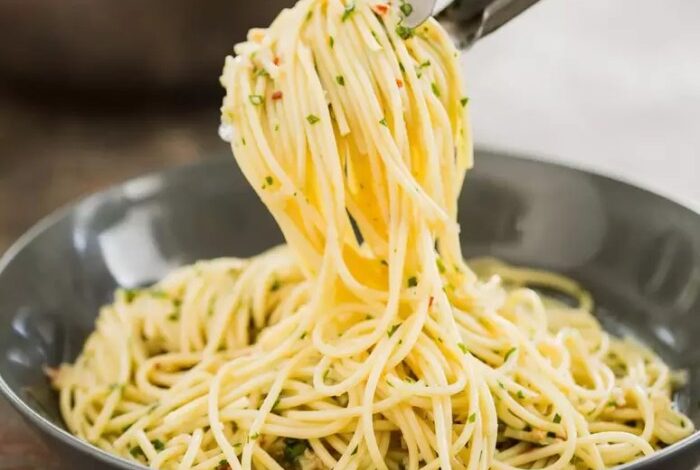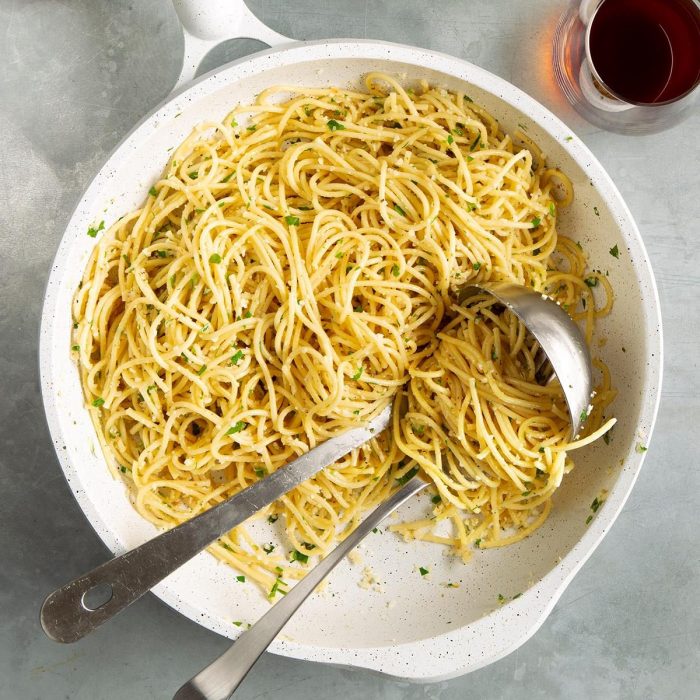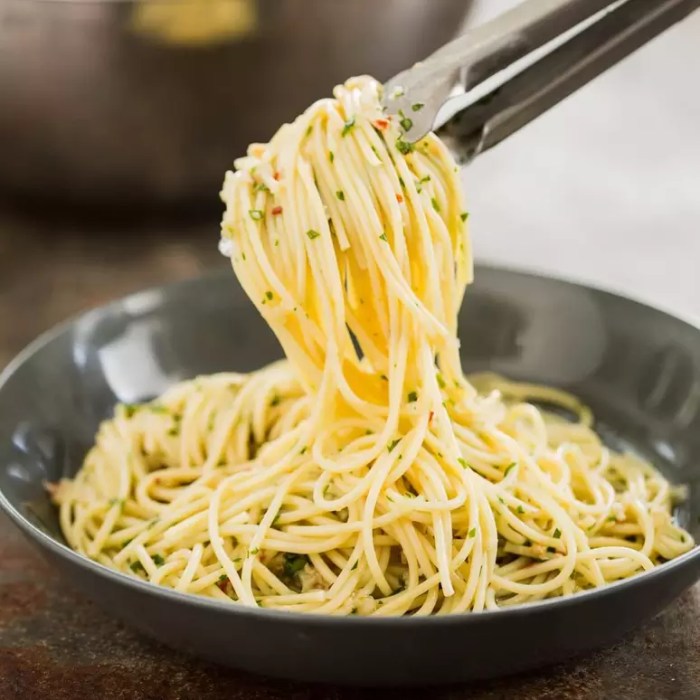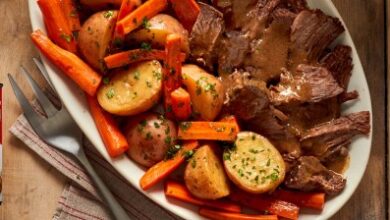
Spaghetti Aglio e Olio: A Simple Italian Masterpiece
Spaghetti aglio e olio, meaning “garlic and oil,” is a classic Italian pasta dish that embodies simplicity and flavor. It’s a testament to the power of a few key ingredients, expertly combined to create a symphony of taste. While its origins are shrouded in culinary history, one thing is certain: spaghetti aglio e olio is a dish that has captivated generations with its rustic charm and irresistible aroma.
The beauty of this dish lies in its versatility. It’s a blank canvas for creativity, allowing for personal touches and variations based on individual preferences. From the addition of red pepper flakes for a touch of heat to a sprinkle of fresh parsley for a burst of freshness, there are endless ways to personalize this culinary masterpiece.
History and Origins
Spaghetti aglio e olio, a simple yet captivating dish, has a rich history that stretches back centuries, intertwining with the culinary traditions of Italy. Its origins, like many classic Italian dishes, are rooted in the resourcefulness and ingenuity of everyday cooks.
Early Origins and Influences
The origins of spaghetti aglio e olio can be traced back to the ancient Roman Empire. While the exact recipe may have evolved over time, the basic components – spaghetti, garlic, olive oil, and salt – were readily available ingredients in ancient Roman cuisine.
The use of garlic, olive oil, and salt was common in Roman cooking, and the Romans were known to enjoy pasta-like dishes made from grains. The combination of these elements likely formed the foundation of what we know today as spaghetti aglio e olio.
Ingredients and Preparation
The simplicity of spaghetti aglio e olio lies in its minimal ingredients, each playing a crucial role in creating its unique flavor profile. This dish is a testament to the power of using high-quality ingredients and mastering basic cooking techniques.The essence of this dish lies in the perfect balance of garlic, olive oil, and chili flakes.
The right type of pasta, preferably spaghetti, completes the symphony of flavors.
Ingredients
The key ingredients for a traditional spaghetti aglio e olio are:
- Spaghetti:The choice of pasta is essential. Spaghetti, with its long, thin strands, provides the perfect surface area for the sauce to cling to. Other pasta shapes like linguine or bucatini can also be used, but spaghetti is the classic choice.
- Olive Oil:Extra virgin olive oil is the preferred choice for its robust flavor and fruity notes. The oil should be of high quality, as it forms the base of the sauce and significantly influences the final flavor.
- Garlic:Fresh garlic cloves are essential for the distinct aroma and flavor of the dish. The amount of garlic used can be adjusted to taste, but a generous amount is recommended for a truly flavorful dish.
- Chili Flakes:Red pepper flakes add a touch of heat and depth to the dish. The amount can be adjusted based on personal preference, ranging from a subtle hint of spice to a fiery kick.
- Salt:Salt is essential for enhancing the flavors of the other ingredients and balancing the overall taste of the dish.
- Fresh Parsley:Chopped parsley is traditionally added at the end to provide a fresh, herbaceous flavor and vibrant color.
- Optional Ingredients:Variations on the traditional recipe often include additional ingredients like anchovies, pancetta, or lemon zest, which add complexity and depth to the flavor profile.
Preparation
The preparation of spaghetti aglio e olio is a simple yet crucial process that involves several steps:
- Cook the Pasta:Bring a large pot of salted water to a rolling boil. Add the spaghetti and cook until al dente, following the package instructions.
- Prepare the Sauce:While the pasta is cooking, heat the olive oil in a large skillet over medium heat. Add the garlic cloves and cook until fragrant, about 30 seconds, being careful not to burn them. Add the chili flakes and cook for a few more seconds.
- Combine the Pasta and Sauce:Drain the cooked pasta, reserving about 1/2 cup of the pasta water. Add the pasta to the skillet with the garlic and chili oil, tossing to coat. Add a few tablespoons of the reserved pasta water to loosen the sauce, if needed.
- Finish the Dish:Stir in the chopped parsley and season with salt to taste. Serve immediately, garnished with additional parsley, if desired.
Variations
Spaghetti aglio e olio offers endless possibilities for customization, with variations that cater to different tastes and preferences. Here’s a table comparing some common variations:
| Variation | Key Ingredients | Flavor Profile |
|---|---|---|
| Classic | Spaghetti, olive oil, garlic, chili flakes, salt, parsley | Simple, garlicky, slightly spicy, with a bright herbaceous finish. |
| Anchovy | Spaghetti, olive oil, garlic, chili flakes, salt, parsley, anchovies | Adds a salty, umami depth to the dish. |
| Pancetta | Spaghetti, olive oil, garlic, chili flakes, salt, parsley, pancetta | Introduces a smoky, savory flavor and adds richness to the dish. |
| Lemon | Spaghetti, olive oil, garlic, chili flakes, salt, parsley, lemon zest | Adds a bright, citrusy note and balances the richness of the dish. |
Flavor Profile and Sensory Experience: Spaghetti Aglio E Olio

The magic of spaghetti aglio e olio lies not in the complexity of its ingredients, but in the perfect harmony of simple flavors that dance on your palate. The dish offers a delightful sensory experience, from the intoxicating aroma of garlic and olive oil to the satisfying bite of al dente pasta.
Flavor Notes and Aromas
The primary flavors of spaghetti aglio e olio are garlic, olive oil, and black pepper. The garlic, sauteed in olive oil, releases its pungent aroma, creating a rich and savory base. The olive oil, typically extra virgin, adds a fruity and slightly bitter note, while the black pepper provides a spicy kick.
The combination of these flavors creates a symphony of taste that is both comforting and invigorating.
Sometimes, the simplest dishes are the most satisfying. Spaghetti aglio e olio, with its garlicky, oily goodness, is a perfect example. But if you’re looking for something a bit more robust and hearty, you might want to check out chef johns bigos polish hunters stew.
It’s a rich and flavorful stew that’s perfect for a cold winter night. Of course, nothing beats the classic simplicity of spaghetti aglio e olio, especially when you’re craving a quick and comforting meal.
Textural Qualities
The textural experience of spaghetti aglio e olio is equally important. The pasta, cooked al dente, offers a firm bite that contrasts beautifully with the creamy, slightly oily sauce. The sauce itself, while simple, has a unique texture. It clings to the pasta, coating it in a thin, flavorful film.
Spaghetti aglio e olio is a classic Italian dish that’s all about simplicity and flavor. The garlic and olive oil create a rich sauce that perfectly complements the al dente pasta. While I’m usually all about cooking from scratch, sometimes I crave a quick and easy side.
That’s when I turn to microwave corn on the cob for a fresh and sweet addition to my spaghetti aglio e olio meal.
This interplay of textures creates a delightful dining experience that is both satisfying and elegant.
Personal Experience
For me, spaghetti aglio e olio is a dish that evokes memories of warm summer evenings spent with friends and family. The aroma of garlic and olive oil fills the air, creating a sense of comfort and anticipation. The first bite is a burst of flavor, the al dente pasta offering a satisfying chew, while the sauce coats my palate with its savory goodness.
Each mouthful is a reminder of the simplicity and beauty of good food.
Cultural Significance and Popularity
Spaghetti aglio e olio, despite its simple ingredients, holds a significant place in Italian culinary culture and has gained global popularity. Its origins and simplicity make it a dish that resonates with people from various backgrounds, and its versatility allows for endless variations and adaptations.
Popularity and Cultural Significance in Italy
Spaghetti aglio e olio is a staple dish in Italian cuisine, particularly in the region of Lazio, where it originated. It is often considered a “poor man’s dish” due to its use of inexpensive ingredients. However, its simplicity and deliciousness have made it a beloved dish across all socioeconomic classes.
The dish is often served as a first course or light lunch, and its versatility allows it to be enjoyed in various settings, from casual family meals to more formal gatherings.
Global Popularity and Contemporary Culinary Culture
Spaghetti aglio e olio has gained immense popularity worldwide, becoming a ubiquitous dish in many restaurants and homes. Its simple preparation and readily available ingredients have made it a popular choice for home cooks. The dish’s popularity has also been fueled by its versatility, allowing for numerous variations and adaptations to suit different tastes and dietary preferences.
For instance, the addition of chili flakes, anchovies, or other spices can enhance the flavor profile.
Examples of How the Dish is Served and Enjoyed
Spaghetti aglio e olio is a dish that can be enjoyed in a variety of ways, depending on the occasion and personal preferences.
Spaghetti aglio e olio is a simple yet delicious dish, relying on the perfect balance of garlic, olive oil, and a sprinkle of red pepper flakes. It’s a great choice for a quick and easy weeknight meal, but sometimes I crave something a bit lighter in the morning.
That’s when I turn to these spinach egg white muffins , which are packed with protein and veggies. But don’t worry, I always have a jar of my favorite spaghetti sauce on hand for when I’m ready to enjoy a hearty bowl of aglio e olio again!
- In Italy, it is often served as a first course, followed by a main course of meat or fish.
- In casual settings, it can be enjoyed as a light lunch or dinner, often accompanied by a simple salad or bread.
- In more formal settings, it can be served as a sophisticated appetizer or main course, with the addition of fresh herbs, parmesan cheese, or other garnishes.
- The dish is also popular in street food stalls and markets, where it is often served as a quick and satisfying meal.
Variations and Adaptations

Spaghetti aglio e olio, in its simplicity, lends itself beautifully to creative variations and adaptations. While the core elements of garlic, olive oil, and pasta remain constant, chefs and home cooks alike have explored countless ways to enhance and personalize this classic dish.
Common Variations
The addition of different ingredients is a popular way to create variations on spaghetti aglio e olio. Some common additions include:
- Chili flakes: A touch of heat can add complexity and depth to the flavor profile.
- Red pepper flakes: Similar to chili flakes, these add a subtle kick and a vibrant color.
- Fresh herbs: Parsley, basil, oregano, and thyme are popular additions that bring fresh, aromatic notes.
- Lemon zest: A burst of citrus adds brightness and acidity, balancing the richness of the olive oil.
- Seafood: Shrimp, mussels, or clams can be added to create a more substantial and flavorful dish.
- Vegetables: Roasted or sauteed vegetables, such as cherry tomatoes, mushrooms, or spinach, can be incorporated to add texture and flavor.
Another way to vary spaghetti aglio e olio is through different cooking techniques. For instance, some chefs prefer to cook the garlic in the olive oil until it becomes golden brown, resulting in a more intense flavor. Others may use a combination of olive oil and butter for a richer, creamier sauce.
Variations Table
| Variation | Unique Characteristics | Flavor Profile |
|---|---|---|
| Spaghetti aglio e olio with chili flakes | Adds a spicy kick to the dish. | Garlicky, oily, spicy. |
| Spaghetti aglio e olio with fresh basil | Adds a fresh, herbaceous flavor. | Garlicky, oily, herbaceous. |
| Spaghetti aglio e olio with lemon zest | Adds a bright, citrusy flavor. | Garlicky, oily, citrusy. |
| Spaghetti aglio e olio with shrimp | Adds a protein source and a briny flavor. | Garlicky, oily, briny, seafood. |
| Spaghetti aglio e olio with cherry tomatoes | Adds sweetness and acidity. | Garlicky, oily, sweet, tangy. |
Potential Adaptations and Innovations, Spaghetti aglio e olio
The simplicity of spaghetti aglio e olio makes it a canvas for culinary creativity. Future adaptations and innovations could include:
- Infused olive oils: Using olive oil infused with herbs, spices, or citrus zest can add depth and complexity to the flavor profile.
- Non-traditional pasta shapes: Exploring different pasta shapes beyond spaghetti, such as linguine or bucatini, could offer unique textural experiences.
- Molecular gastronomy techniques: Applying techniques like spherification or emulsification could create innovative textures and presentations.
- Fusion flavors: Combining elements from different cuisines, such as Asian or Mexican flavors, could result in exciting and unexpected flavor combinations.
Pairing and Accompaniments
Spaghetti aglio e olio, with its simple yet powerful flavor profile, calls for thoughtful pairings that complement and enhance its inherent qualities. The dish’s robust garlic notes, the subtle spiciness of red pepper flakes, and the richness of olive oil demand careful consideration when choosing wines and accompaniments.
Wine Pairings
The ideal wine pairing for spaghetti aglio e olio should possess a light body, a refreshing acidity, and a subtle complexity that harmonizes with the dish’s flavors. Here are some suggested pairings:
- Dry White Wines:
- Vermentino (Italy):This crisp, aromatic white wine from Sardinia offers notes of citrus, herbs, and a touch of minerality, making it an excellent complement to the garlic and olive oil in the dish.
- Pinot Grigio (Italy):Known for its light body, crisp acidity, and subtle fruity notes, Pinot Grigio provides a refreshing contrast to the richness of the pasta.
- Sauvignon Blanc (New Zealand):With its vibrant acidity and herbaceous notes, Sauvignon Blanc from New Zealand can stand up to the garlic and olive oil while adding a refreshing element.
- Dry Rosé Wines:
- Provence Rosé (France):This delicate rosé, known for its pale color, dry palate, and subtle fruity notes, offers a refreshing and elegant accompaniment to the pasta.
- Tavel Rosé (France):This full-bodied rosé, with its bolder flavors of red fruit and a hint of spice, can complement the garlic and red pepper flakes in the dish.
Side Dishes and Appetizers
Side dishes and appetizers should complement the simplicity of spaghetti aglio e olio, offering a contrast in texture or flavor. Here are some suggestions:
- Caprese Salad:The classic combination of fresh mozzarella, ripe tomatoes, and basil provides a refreshing and vibrant counterpoint to the richness of the pasta.
- Bruschetta:Toasted bread topped with olive oil, garlic, and tomatoes offers a similar flavor profile to the pasta, enhancing the overall dining experience.
- Grilled Vegetables:Grilled zucchini, eggplant, or bell peppers add a smoky element and contrasting textures to the dish.
Presentation and Plating
Presentation plays a crucial role in elevating the dining experience. Spaghetti aglio e olio, with its simple elegance, benefits from a clean and minimalist plating style.
- Serving Size:Serve the pasta in a shallow bowl or on a plate, allowing the sauce to be visible.
- Garnish:A sprinkle of fresh parsley, a drizzle of olive oil, or a pinch of red pepper flakes can add visual appeal and enhance the flavor.
- Simplicity:Avoid overcrowding the plate with too many elements, allowing the pasta to be the star of the dish.






